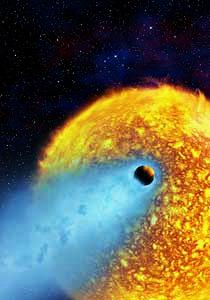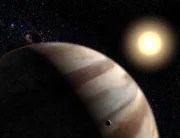5 min read

Based on
Release
 |
This artist's illustration shows a dramatic close-up of the scorched extrasolar planet HD 209458b in its orbit only 4 million miles from its yellow, Sun-like star. The planet is a type of extrasolar planet known as a "hot Jupiter." Credit: ESA, Alfred Vidal-Madjar (Institut d'Astrophysique de Paris, CNRS, France) and NASA |
For the first time, astronomers using NASA's Hubble Space Telescope have observed the atmosphere of an extrasolar planet evaporating off into space. Much of the planet may eventually disappear, leaving only a dense core. The planet is a type of extrasolar planet known as a "hot
." These giant gaseous planets orbit their parent stars very closely, drawn to them like moths to a flame.
The scorched planet, called HD 209458b, orbits only 4 million miles (7 million kilometers) from its yellow, Sun-like star. The Hubble observations reveal a hot and puffed up evaporating hydrogen atmosphere surrounding the planet. This huge envelope of hydrogen resembles a comet with a tail trailing behind the planet. The planet circles the parent star in a tight, 3.5-day orbit. Earth also has an extended atmosphere of escaping hydrogen gas, but the loss rate is much lower.
An international team of astronomers, led by Alfred Vidal-Madjar of the Institut d'Astrophysique de Paris, CNRS, France, is reporting this discovery in the March 13
magazine. "We were astonished to see that the hydrogen atmosphere of this planet extends over 124,000 miles (200,000 kilometers)," says Vidal-Madjar.
HD 209458b is too close to the star for Hubble to photograph directly. However, astronomers could observe the planet indirectly since it blocks light from a small part of the star during transits across the disk of the star, thereby dimming it slightly. Light passing through the atmosphere around the planet is scattered and acquires a signature from the atmosphere. In a similar way, the Sun's light is reddened as it passes obliquely through the Earth's atmosphere at sunset. Astronomers used Hubble's Space Telescope Imaging Spectrograph (STIS) to measure how much of the planet's atmosphere filters light from the star. They saw a startling drop in the
. A huge puffed up atmosphere can best explain this result.
Artist's conception of a gas giant planet orbiting a nearby star. Credit: NASA and G. Bacon (STScI) |
The planet's outer atmosphere is extended and heated so much by the nearby star that it starts to escape the planet's gravity. "The atmosphere is heated, the hydrogen escapes the planet's gravitational pull and is pushed away by the starlight, fanning out in a large tail behind the planet -- like that of a comet," says Alain Lecavelier, des Etangs at the Institut d'Astrophysique de Paris, CNRS, France. Astronomers estimate the amount of hydrogen gas escaping HD 209458b to be at least 10,000 tons per second, but possibly much more.
Hot Jupiters orbit precariously close to their stars. They are giant gaseous planets that must have formed in the cold outer reaches of the star system and then spiraled into their close orbits. This new discovery might help explain why hot Jupiters so often orbit a few million miles from their parent stars. Like HD 209458b, they are not usually found much closer than 4 million miles. Currently, the closest distance is 3.5 million miles (5.7 million kilometers). Hot Jupiters have orbits that are as brief as three days, but not shorter. Perhaps the evaporation of the atmosphere plays a role in setting an inner boundary for orbits of hot Jupiters.
HD 209458b has a diameter 1.3 times that of Jupiter, and two-thirds the mass. Its orbit is one-eighth the size of Mercury's orbit around the Sun. The parent star is similar to our Sun and lies 150 light-years from Earth. It is visible with binoculars as a seventh magnitude star in the constellation Pegasus. In 1999 this star suddenly entered the astronomical "Hall of Fame" when HD 209458b was seen passing
and partly eclipsing it. This was the first confirmed transiting extrasolar planet ever discovered. In 2001 Hubble
in the lower part of HD 209458b's atmosphere, the first signature of an atmosphere on any extrasolar planet.
What's Next
NASA's planned Kepler mission will monitor thousands of stars over a four-year period, searching for transiting planets. Kepler will be sensitive enough to detect Earth-sized worlds, if any exist, around several hundred nearby stars. These studies will then lead to the ambitious Terrestrial Planet Finder mission (2012-2015), which will examine extrasolar planets for signs of life.
In December 2001, NASA selected the
, a project based at NASA Ames, as one of the next NASA Discovery missions. The Kepler Mission, scheduled for launch in 2006, will use a spaceborne telescope to search for Earth-like planets around stars beyond our solar system. A key criterion for such suitable planets would be whether they reside in habitable zones, or regions sometimes protected by gas giants but with temperate climates and liquid water.
Future missions, such as
will search for many more and take detailed pictures of stars that might harbor dust rings. As these images become available, astronomers will be able to predict the sizes and orbits of giant planets within the alien solar system.
NASA's Astrobiology Magazine








